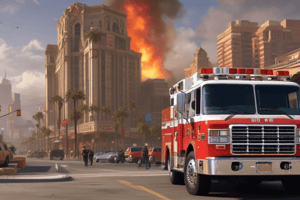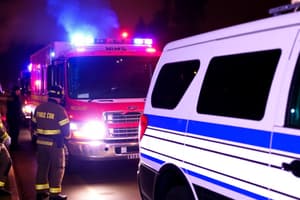Podcast
Questions and Answers
Who is primarily responsible for managing human-induced critical incidents in the Philippines?
Who is primarily responsible for managing human-induced critical incidents in the Philippines?
- National and Local Peace and Order Council (NPOC) (correct)
- Philippine National Police (PNP)
- National Disaster Risk Reduction and Management Council (NDRRMC)
- Crisis Management Committee (CMC)
What is the primary role of the Crisis Management Committee (CMC)?
What is the primary role of the Crisis Management Committee (CMC)?
- Formulate crisis management procedures (correct)
- Conduct training for local police
- Develop disaster resilience strategies
- Provide logistics support during incidents
Which framework is adopted by the PNP for responding to critical incidents?
Which framework is adopted by the PNP for responding to critical incidents?
- National Security Act
- Incident Command System (ICS) (correct)
- Operational Readiness Protocol
- Crisis Response Initiative
What is a key focus of the National Peace and Order Council (NPOC)?
What is a key focus of the National Peace and Order Council (NPOC)?
What is the role of lower-level organizations under the NPOC and NDRRMC?
What is the role of lower-level organizations under the NPOC and NDRRMC?
What essential function does the Incident Command System (ICS) provide for the PNP?
What essential function does the Incident Command System (ICS) provide for the PNP?
Which entity is specifically mentioned as chairing the National Peace and Order Council (NPOC)?
Which entity is specifically mentioned as chairing the National Peace and Order Council (NPOC)?
What aspect does the document emphasize regarding crisis management efforts?
What aspect does the document emphasize regarding crisis management efforts?
What is the role of the PNP during a natural calamity or disaster?
What is the role of the PNP during a natural calamity or disaster?
Which of the following is NOT one of the stages in disaster management?
Which of the following is NOT one of the stages in disaster management?
In the Incident Command System (ICS), which of the following is considered an optional functional area?
In the Incident Command System (ICS), which of the following is considered an optional functional area?
What must the Incident Commander do upon assessing a hostage situation?
What must the Incident Commander do upon assessing a hostage situation?
Which group is primarily responsible for the identification of remains of victims during natural calamities?
Which group is primarily responsible for the identification of remains of victims during natural calamities?
What does the acronym POC stand for in the context of emergency management?
What does the acronym POC stand for in the context of emergency management?
What is the primary objective of the PNP in responding to critical incidents?
What is the primary objective of the PNP in responding to critical incidents?
What is the focus of the Post-Disaster Stage in disaster management?
What is the focus of the Post-Disaster Stage in disaster management?
Which component of crisis management includes the steps Predict, Prevent, Prepare, Perform, and Post-Action?
Which component of crisis management includes the steps Predict, Prevent, Prepare, Perform, and Post-Action?
Who designates the Incident Commander in local Crisis Management Committees (CMCs)?
Who designates the Incident Commander in local Crisis Management Committees (CMCs)?
What is the main purpose of the Incident Command System (ICS)?
What is the main purpose of the Incident Command System (ICS)?
Which agency is responsible for disseminating terrorism and threat group alert levels?
Which agency is responsible for disseminating terrorism and threat group alert levels?
What is the primary action taken by first responders at a hostage situation?
What is the primary action taken by first responders at a hostage situation?
What is the first action to take upon receiving a bomb threat?
What is the first action to take upon receiving a bomb threat?
Which of the following is NOT part of the procedures for managing a bomb explosion?
Which of the following is NOT part of the procedures for managing a bomb explosion?
What should be done after the neutralization of a hostage-taker?
What should be done after the neutralization of a hostage-taker?
In a civil disturbance situation, when should the commitment of a CDM contingent be considered?
In a civil disturbance situation, when should the commitment of a CDM contingent be considered?
What is one of the objectives during crowd control operations?
What is one of the objectives during crowd control operations?
What must be done before allowing the public to return to an area after an incident involving explosives?
What must be done before allowing the public to return to an area after an incident involving explosives?
During the processing of hostages after a crisis, which action is essential?
During the processing of hostages after a crisis, which action is essential?
What is the key guideline regarding the use of force by a CDM contingent?
What is the key guideline regarding the use of force by a CDM contingent?
Which step is NOT involved when a suspicious item is found during a bomb threat response?
Which step is NOT involved when a suspicious item is found during a bomb threat response?
How should officers proceed if a suspected explosive device is confirmed present?
How should officers proceed if a suspected explosive device is confirmed present?
What should be prioritized when facilitating hostage receptions?
What should be prioritized when facilitating hostage receptions?
Which action is essential during the evaluation of a bomb threat?
Which action is essential during the evaluation of a bomb threat?
What is the role of the Incident Commander (IC) during a hostage situation?
What is the role of the Incident Commander (IC) during a hostage situation?
In the event of crowd control operations, what is one approach to minimize escalation?
In the event of crowd control operations, what is one approach to minimize escalation?
Flashcards
What is the PNP's role during a crisis?
What is the PNP's role during a crisis?
The PNP's primary responsibility during crisis situations. It involves establishing a committee to support national and local councils.
What is the CIMC?
What is the CIMC?
A specialized committee formed within the PNP to support the NPOC and NDRRMC during critical incidents. They manage the response and ensure coordination with other agencies.
What is the NPOC?
What is the NPOC?
The National and Local Peace and Order Council. They are responsible for managing human-induced critical incidents like protests or riots.
What is the NDRRMC?
What is the NDRRMC?
Signup and view all the flashcards
What is the Incident Command System (ICS)?
What is the Incident Command System (ICS)?
Signup and view all the flashcards
What are the stages of incident management?
What are the stages of incident management?
Signup and view all the flashcards
What is crisis management?
What is crisis management?
Signup and view all the flashcards
What is the importance of collaboration in crisis management?
What is the importance of collaboration in crisis management?
Signup and view all the flashcards
Pre-Disaster Stage
Pre-Disaster Stage
Signup and view all the flashcards
Disaster Response Stage
Disaster Response Stage
Signup and view all the flashcards
Post-Disaster Stage
Post-Disaster Stage
Signup and view all the flashcards
5Ps of Crisis Management
5Ps of Crisis Management
Signup and view all the flashcards
Incident Command System (ICS)
Incident Command System (ICS)
Signup and view all the flashcards
Incident Commander (IC) Role in Hostage Situation
Incident Commander (IC) Role in Hostage Situation
Signup and view all the flashcards
First Responders in Hostage Situation
First Responders in Hostage Situation
Signup and view all the flashcards
Hostage Negotiation Team (HNT)
Hostage Negotiation Team (HNT)
Signup and view all the flashcards
Hostage Negotiation Team (HNT) Leader
Hostage Negotiation Team (HNT) Leader
Signup and view all the flashcards
HNT Primary Negotiator
HNT Primary Negotiator
Signup and view all the flashcards
HNT Secondary Negotiator
HNT Secondary Negotiator
Signup and view all the flashcards
HNT Intelligence Liaison
HNT Intelligence Liaison
Signup and view all the flashcards
HNT Recorder
HNT Recorder
Signup and view all the flashcards
HNT Board Negotiator
HNT Board Negotiator
Signup and view all the flashcards
Hostage Negotiation Team
Hostage Negotiation Team
Signup and view all the flashcards
Explosive Ordnance Disposal Team (EODT)
Explosive Ordnance Disposal Team (EODT)
Signup and view all the flashcards
Crisis Management Committee (CMC)
Crisis Management Committee (CMC)
Signup and view all the flashcards
Crowd Control Unit
Crowd Control Unit
Signup and view all the flashcards
Critical Incident Management and Tactical Group (CIMTG)
Critical Incident Management and Tactical Group (CIMTG)
Signup and view all the flashcards
Force Continuum
Force Continuum
Signup and view all the flashcards
First Responders (FR)
First Responders (FR)
Signup and view all the flashcards
Initiate contact and obtain information
Initiate contact and obtain information
Signup and view all the flashcards
Give updates to the IC (Incident Commander)
Give updates to the IC (Incident Commander)
Signup and view all the flashcards
Evaluate alternative options
Evaluate alternative options
Signup and view all the flashcards
Recommend activating CMC and CIMTG
Recommend activating CMC and CIMTG
Signup and view all the flashcards
Facilitate deliveries, hostage receptions
Facilitate deliveries, hostage receptions
Signup and view all the flashcards
Attend meetings called by CMC or IC
Attend meetings called by CMC or IC
Signup and view all the flashcards
Initiate case conferences
Initiate case conferences
Signup and view all the flashcards
Issue press statements
Issue press statements
Signup and view all the flashcards
Study Notes
Philippine National Police (PNP) Critical Incident Management
- Responsibility:
- Human-induced incidents (man-made crises) are the responsibility of the National and Local Peace and Order Councils (NPOC).
- Natural calamities and disasters fall under the National and Local Disaster Risk Reduction and Management Council (NDRRMC).
- PNP plays a proactive role, organizing its own Critical Incident Management Committee (CIMC) to aid NPOC and NDRRMC.
Incident Command System (ICS)
- Adoption: ICS adopted as standard response framework for critical incidents.
- Structure: Six major functional areas: Command, Operations, Planning, Logistics, Finance, Administration, and optionally Intelligence/Investigation (case-dependent).
- Institution: ICS institutionalized by the Philippine government through RA 10121 (DRRM Law), NDRRMC Mem. Circular No. 4 (2012), and Executive Order No. 82 (2012).
- Implementation: ICS is part of the Office of the Civil Defense (OCD) and used by DRRM Councils and response groups for coordinated actions.
Crisis Management Committee (CMC)
- Function: Formulates procedures, integrates government, military, police, and public efforts.
- Scope: All CMC actions are within the policies of the associated Peace and Order Councils (POCs).
- Hierarchy: National and Local levels, chaired respectively by the Secretary of Interior and Local Government (SILG) and local chief executives.
- Incident Commander (IC): The designated officer in charge during a crisis; local chief executive can be IC, in which case the CIMTG is activated for assistance.
Types of Critical Incidents
- Natural Calamity/Disaster: PNP first responders provide area security and support search/rescue operations led by area DRRMC.
- Human-Induced Incident: PNP responds differently, supporting the NPOC or relevant CMCs, with goals of saving lives/property, resolving incidents, and restoring normalcy.
Disaster Management Stages
- Pre-Disaster: Proactive assessment, risk mapping, identifying disaster-prone areas.
- Disaster Response: Level 2 (Red), event of natural or human-induced crisis/calamity, immediate response and deployment of personnel.
- Post-Disaster: Level 3 (White), support for recovery and rehabilitation efforts; PNP takes lead in identifying remains of victims in human-induced disasters, NBI in natural disasters.
Alert Levels (Human-Induced)
- Terrorism and threat group alert levels disseminated by the TDI to all offices based on NICA information.
Hostage Situations
- First Responders (FR): Secure the scene, contact hostage-taker, update concerned parties, evacuate.
- Incident Commander (IC): Plans negotiation, possible arrest or tactical assault based on evaluation.
- Hostage Negotiation Team (HNT): Negotiation operation center set up for continuous contact with the hostage-taker.
- Post-Incident: Crime scene secured, CSI conducted, witness interviews and case conferences initiated.
Bomb Threats and Bomb Incidents
- Threat Response: Treat all threats seriously, locate the scene, isolate, alert EOD/K9, inform HQ, secure area.
- Evacuation: If evacuation is recommended following EOD/K9 confirmation, management coordinates safety areas, assisted evacuation.
- Explosive Device: Lock-down to at least 300 meters; summon ambulance and fire trucks; request police support.
- Explosion: Cordon the scene, evacuate injured, maintain order, assist EOD/K9 and SOCO.
- Report: Time of threat reception, detonation, type of device; witness statements.
Civil Disturbance Management
- General Guidelines: Assistance to CDM contingents, minimizing force, respecting human rights.
- Specific Guidelines, Operational Tasks, Approaches: Isolates area, securing targets, controlling crowds, arresting violators.
- Force Continuum: Follows established guidelines to prevent escalation.
- Deployment: Large reserve maintained; minimum necessary force usage.
- Equipment: Only permitted tools (batons/shields/helmets), emphasizing avoiding harm.
Studying That Suits You
Use AI to generate personalized quizzes and flashcards to suit your learning preferences.




